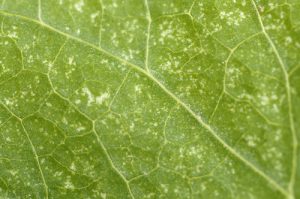Spider Mites Can Infest Your Houseplants
By Chris Williams on December 29, 2011.
Q. In my house, I have a low table in front of a sunny window. In the last couple of weeks, I’ve occasionally found very tiny crawling things on the surface of the table. I don’t find them anywhere else in the house. I think they might be clover mites. Do you think they’re getting in somehow through the window?
A. I don’t think you have clover mites. When a customer complains of tiny crawling mites indoors, our first thought is usually clover mites or bird mites. But, winter is not the time of year when you would except to find these mites. They are both active outdoors, and find their way indoors, during spring or summer months. But there’s another possible source of indoor mites that we don’t see very often, and that is potted plants infested with spider mites. I’m guessing that you might have some houseplants or herbs sitting on that table in the sun.
Spider mites thrive in hot, dry conditions while cool, humid, or rainy weather keeps mite populations down. In our region, people often move their indoor potted plants outside for the summer, then move them back in again before the first frost in the fall. Houseplant infestations of spider mites often first become apparent in November when you first turn the heat on indoors, the air becomes drier, and spider mite populations mushroom.
 Spider mites suck juices from plant foliage (they don’t bite people). They feed on the lower surface of the leaves so if you don’t turn leaves over you may never see them. Spider mites are either already on the plant when purchased (or gifted), or later infest the plant, usually when the plant spends the summer outside.
Spider mites suck juices from plant foliage (they don’t bite people). They feed on the lower surface of the leaves so if you don’t turn leaves over you may never see them. Spider mites are either already on the plant when purchased (or gifted), or later infest the plant, usually when the plant spends the summer outside.
Inspecting Your Houseplants for Spider Mites: You can see spider mites with your naked eye, just barely. To check your houseplants for spider mites, use a magnifying glass. In heavy infestations, the leaves have a speckled or stippled look from feeding punctures. Leaves change color becoming grayish, yellow, or bronze rather than green. Infested plants are also weakened and stunted in growth, and may drop yellow leaves prematurely.
On the underside of the leaves, you will likely see mites of different ages and sizes. In addition to the mites themselves, you should see eggs and shed mite skins. Older leaves are usually infested first, then the mites move on to new leaves. Webbing between leaves and stems is another characteristic of a heavy spider mite infestation. If you look closely, you will see mites moving along the webbing. Another way to check for spider mites is to hold a piece of stiff, white paper under the leaves, then tap several leaves over the paper. You might dislodge the mites which vary in color from yellowish to dark green.
Spider mites don’t travel much; they rarely leave the plant they’re feeding on. They can, however, infest other plants indoors, particularly if the plants are touching. Mites can also drop from the plant and crawl to new plants. And mites can be transported on clothing or objects that touch an infested plant. Spider mites that are found roaming away from the plant will soon die and don’t require any treatment other than vacuuming.
Once you see the stippling and webbing on plants, the infestation is already well established. Spider mites on plants can be very difficult to get rid of, and control requires repeat applications of pesticide, insecticidal soap, or horticultural oil. Unless you particularly value the plant, throwing it out might be the best solution. If you want to try to rescue the plant, ask your local plant nursery or garden shop for advice on which product to use. Make sure the product mentions spider mites on the label.